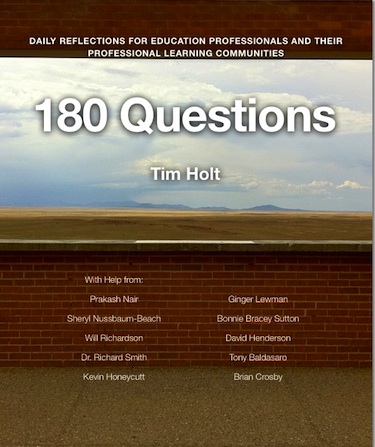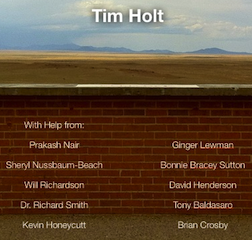 Anyone who still doubts the power of a well-established personal learning network, or the importance of being a connected educator, need look no further than the cover of my new book: 180 Questions: Daily Reflections for Educators and Their Professional Learning Communities. It serves as a good example of what can happen when one works to establish a viable community of virtual colleagues.
Anyone who still doubts the power of a well-established personal learning network, or the importance of being a connected educator, need look no further than the cover of my new book: 180 Questions: Daily Reflections for Educators and Their Professional Learning Communities. It serves as a good example of what can happen when one works to establish a viable community of virtual colleagues.
On the cover, there is a phrase “With Help from” and then a list of some of the members of my own PLN — people that I look up to, people that I follow, people that I learn from.
You’ll find “lead learners” like Sheryl Nussbaum-Beach, Will Richardson, Kevin Honeycutt and others. Each of the 10 people named on the cover is a participant in my network of learners and has chosen to make me part of their network as well.
The book offers a series of questions for Professional Learning Communities (PLCs) that can help them begin thinking more deeply about teaching and learning, instead of simply sitting around and disaggregating data (as many PLCs have devolved into doing).
The germ of the idea for the book came while watching Sheryl and Will presenting at a Powerful Learning Practice event, asking the teachers in my district a series of rapid-fire questions about integrating technology into their lessons. If you have never seen Sheryl or Will present, you know they have very different styles. Yet each of them challenges educators to deepen their thinking, using a series of questions peppered throughout the training day.
Will’s questions tended to be more global and philosophical (Where is education headed?) while Sheryl keep hers close to the classroom (What are your excuses for not using the technology tools?). Both sets of questions were thought-provoking in their own way. While watching them, I thought it would be neat (and useful) to assemble some of the most penetrating questions people are asking about education these days and make that the basis for a book.
From a neat idea to a real book
When I began writing this book I knew that somehow I needed to incorporate the people from my own PLN into it. I didn’t know if I should just mention them, link to their blogs and websites, or do something more. I ended up doing more, but it didn’t start out that way.
When I began sketching out my book idea, I decided to gather all of the questions I’d blogged about, remembered from presentations I’d witnessed, or seen as I wandered through my own version of the education universe. What did Sheryl ask? What was Kevin’s wondering? Where did I hear that good question about experts?
If you think about it, a good portion of all the interesting stuff you come across in your PLN has to do with people asking questions. I started putting my interesting stuff in one place. Eventually, I’d assembled all the questions I could remember, placed them with the person I remember asking the question, and then sort of got stuck. While posting them on Twitter or Plurk.com or in a blog space is okay, it isn’t a good location if you want to access them easily. More to the point, what exactly was I going to do with these questions? How was I going to extend the learning beyond simply asking the readers of my book to ask themselves questions, many of which could potentially be answered with a simple “Yes” or “No”?
PLN to the rescue
 Sort of as a lark one evening, when I was having a particularly long spell of writer’s block, I decided to just go for broke and send emails out to all the folks whose questions had inspired me enough to include them in the final cut of 180 Q’s — one for each day of a traditional school year. My message to them essentially went like this:
Sort of as a lark one evening, when I was having a particularly long spell of writer’s block, I decided to just go for broke and send emails out to all the folks whose questions had inspired me enough to include them in the final cut of 180 Q’s — one for each day of a traditional school year. My message to them essentially went like this:
“I am including a question that you posed that I remembered in my book. Here is the question: (Insert here.) Could you please write a paragraph or two that expands on that idea? I cannot pay you, I can only make you famous if the book ever gets published. Thanks, Tim”
That was it. I sent the email out to about 25 people in my PLN. I didn’t expect many to reply. In fact, I wasn’t sure anyone would reply. What happened next amazed me. Those people that you see on the cover all wrote back and said that they would gladly help me. For free. For no reason other than they were part of my circle of learners. Every single person who responded did so because they were part of my Professional Learning Network. (Sheryl even graciously allowed me to include a video she’d recorded for me for something completely different.)
Could I have completed the book with out this extra help from members of my PLN? Probably. Maybe. Would it have been as good, as powerful, as meaningful? No. By querying my PLN and adding their further thoughts into the mix — by actually showing that what is preached about harvesting wisdom from your PLN can actually happen! — the book not only became a better piece of work, but a testimonial to anyone that questions whether “You need to become a connected educator.”
Whether you know it or not, your PLN is always there, collectively ready to help. Just look at the cover of my book. Who are you getting help from?
Tim Holt
Latest posts by Tim Holt (see all)
- Problem-Based Learning: Our Brains Abhor Cliffhangers - June 6, 2013
- The Ultimate Education Reform: Messy Learning & Problem Solving - April 19, 2013
- Why Problem-Based Learning Is Better - January 10, 2013

